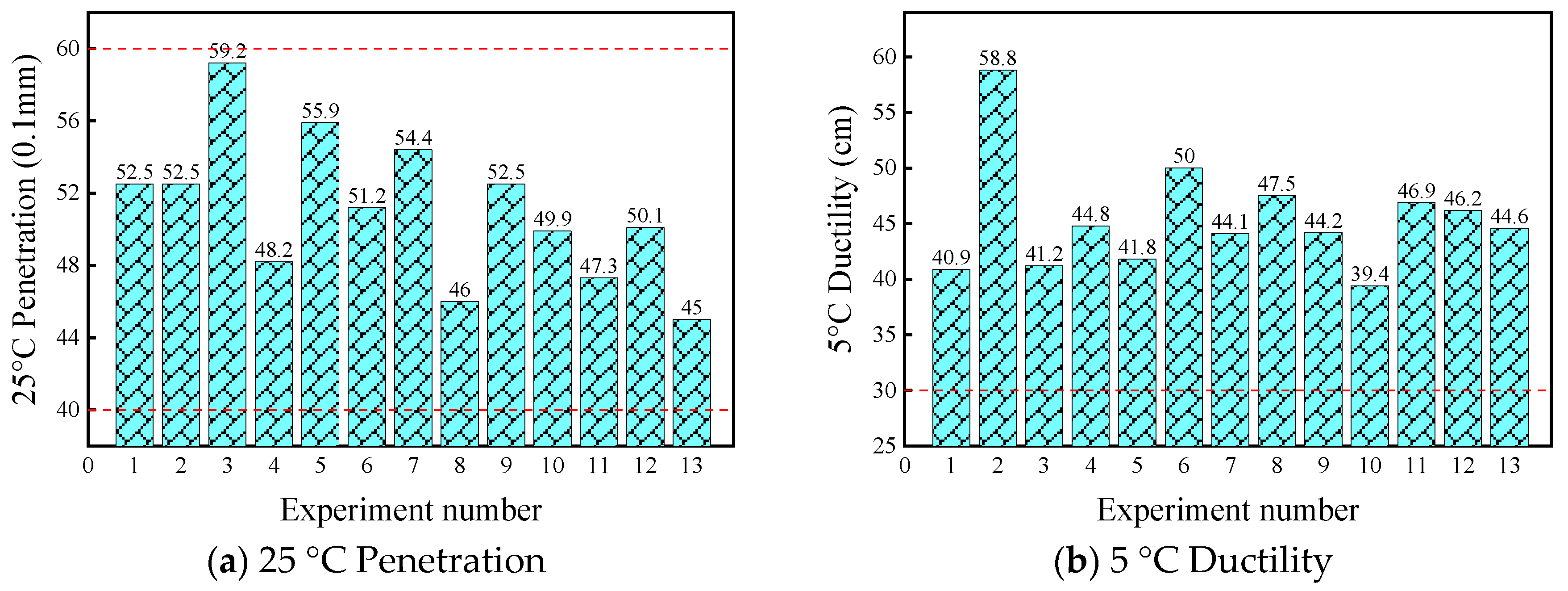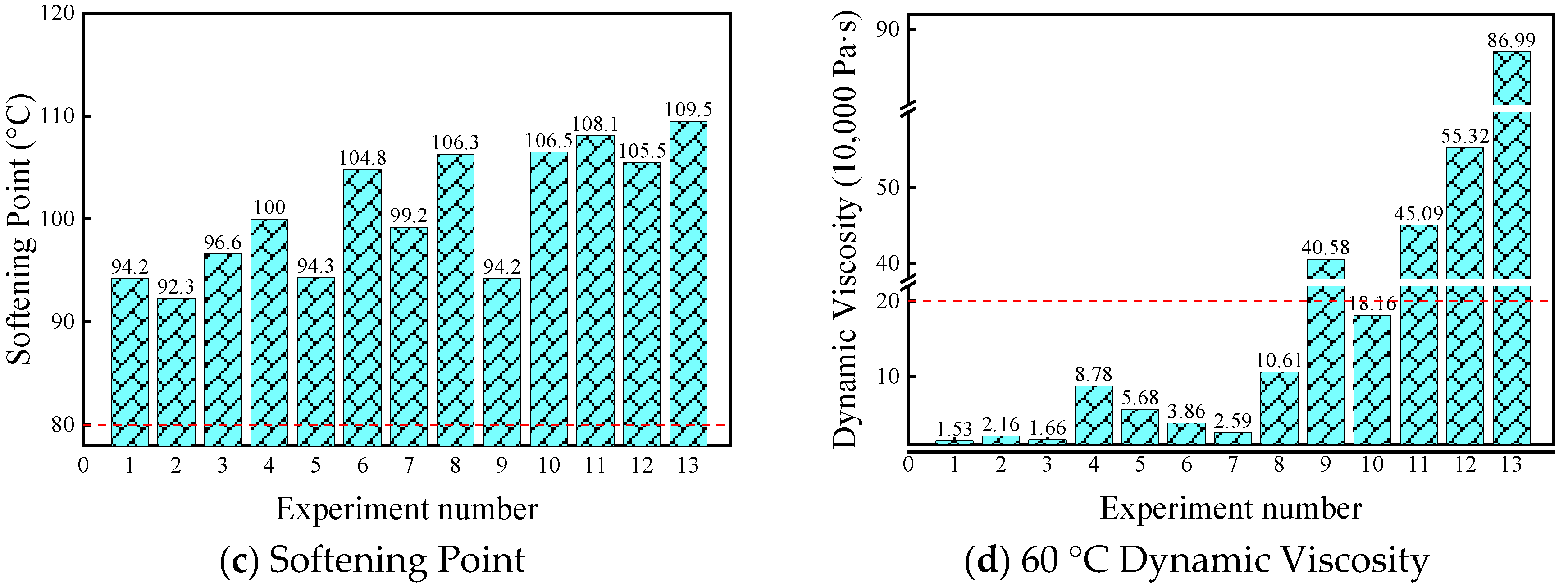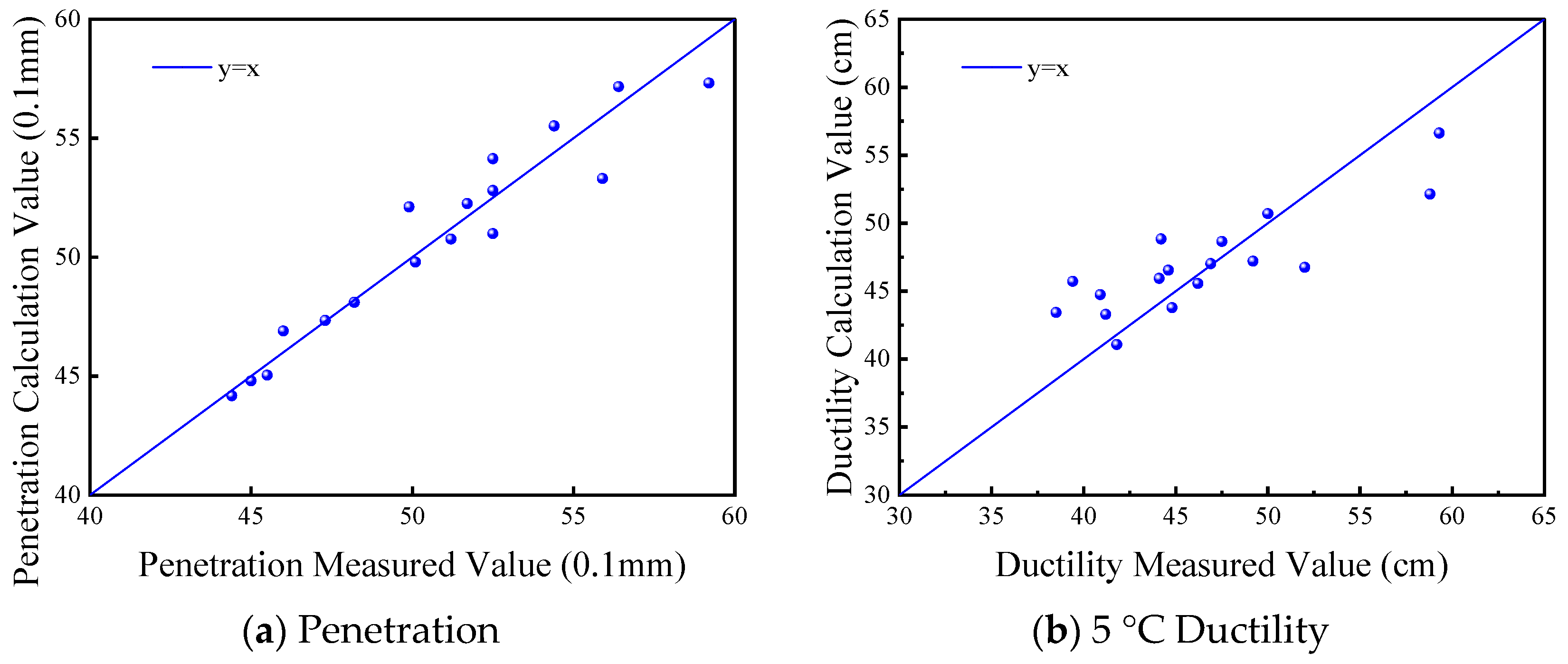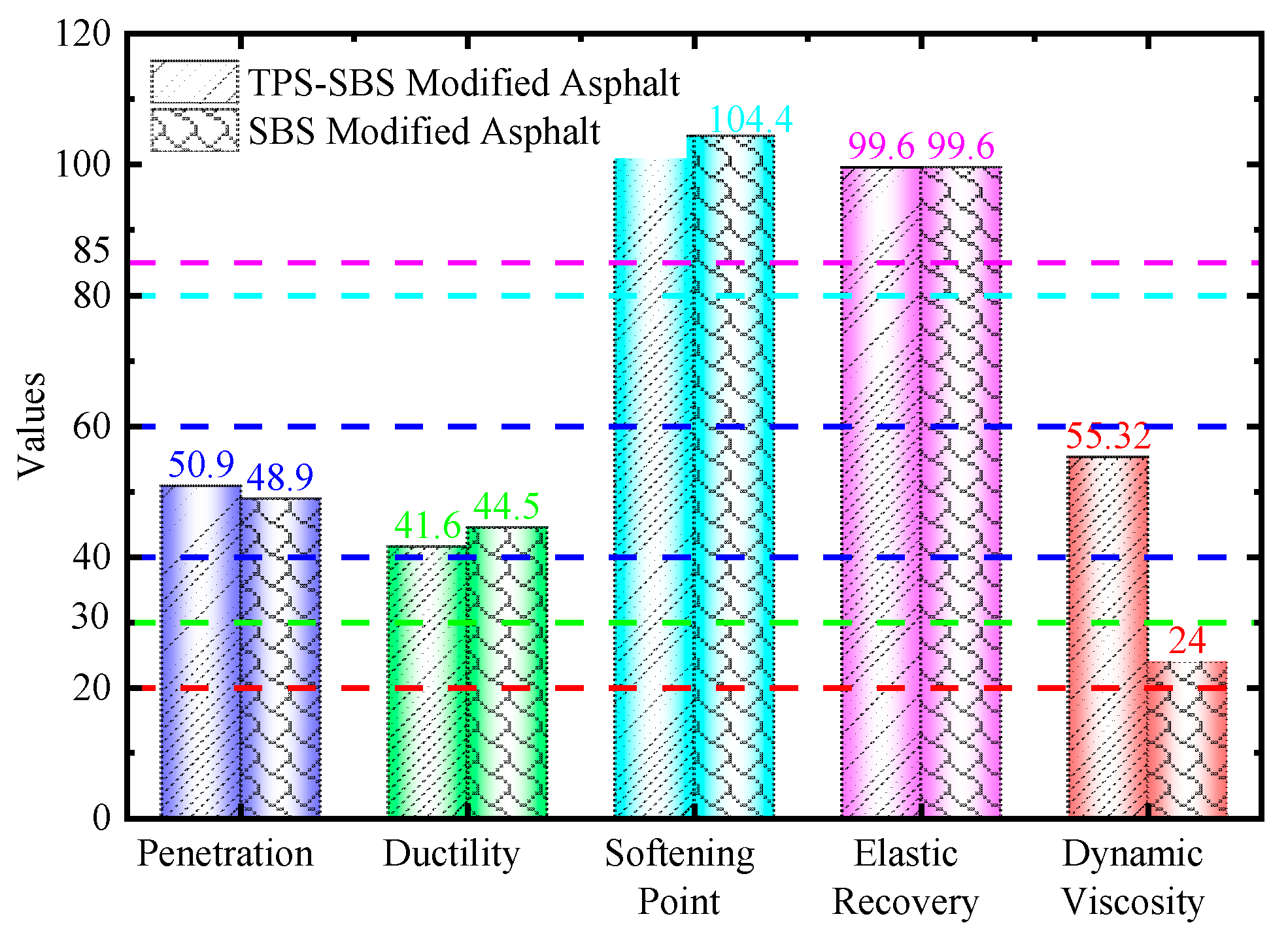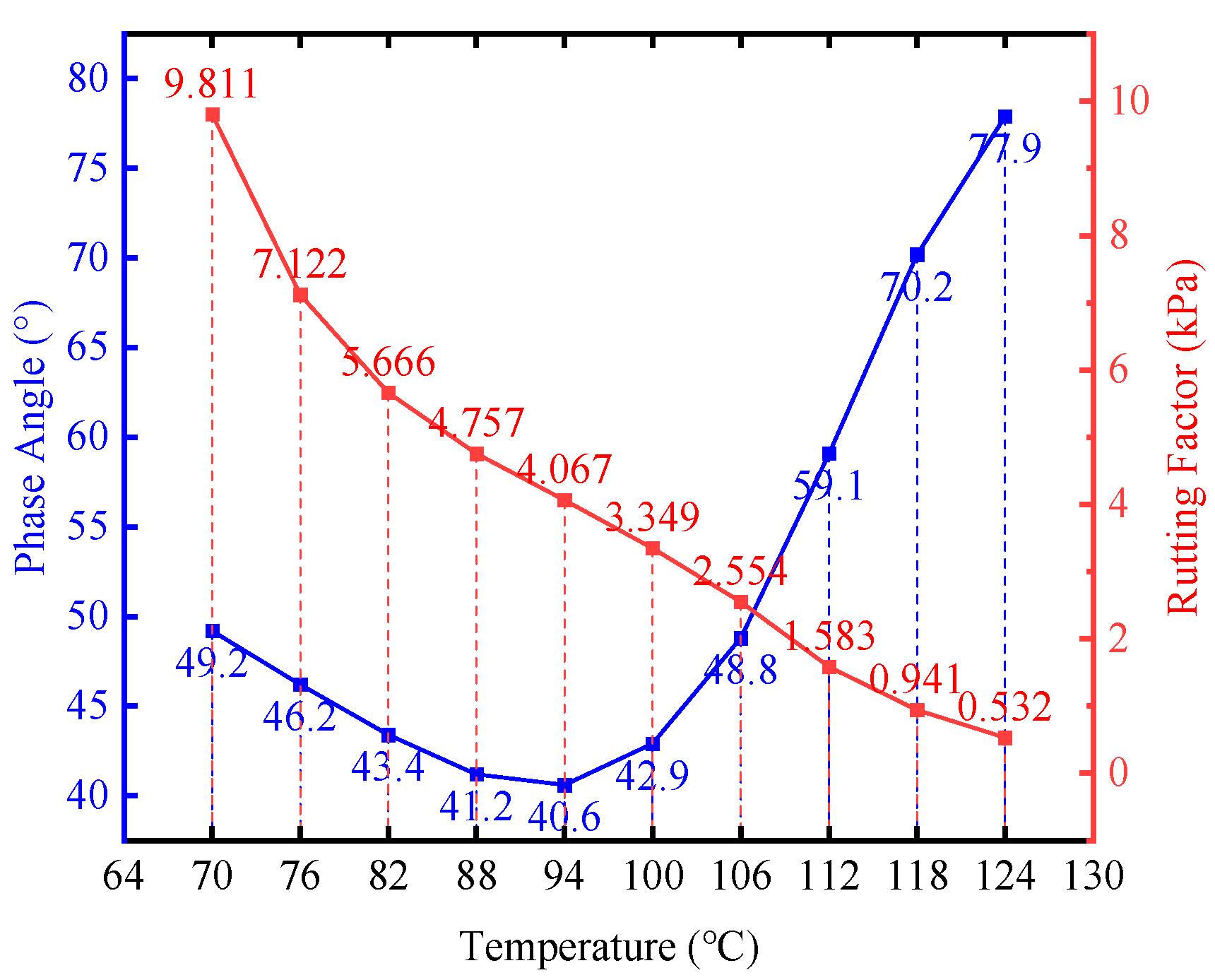1. Introduction
With the increase in traffic volume and the extended service life of highways, road maintenance costs are rising annually, highlighting challenges in funding and management. Asphalt mixtures, the primary material for high-grade highways, often suffer from early damage, primarily manifesting as pavement cracking, which has become a critical factor limiting their performance and service life [
1,
2]. Pavement cracking mainly is reflective cracking from the base layer and fatigue effects in the asphalt surface layer, which is under long-term traffic loads and environmental influences [
3,
4,
5,
6]. This issue is particularly severe in cold regions such as Northeast China, where extreme climate conditions exacerbate the problem. These regions not only experience heavy traffic but also endure summer temperatures exceeding 65 °C and winter temperatures dropping below −30 °C. Frequent freeze-thaw cycles significantly accelerate asphalt pavement damage, leading to a damage rate for asphalt surfaces in high-grade [
7,
8,
9].
Crack prevention and control have become critical to extending the service life of asphalt pavements. The introduction of high-viscosity and high-elasticity modified asphalt offers a promising technical solution [
10,
11]. First proposed in Japan, the core technical criterion of this technology is that the dynamic viscosity at 60 °C must be no less than 20,000 Pa·s [
12,
13]. Currently, this remains the primary technical requirement for most high-viscosity and high-elasticity modified asphalts. Only a few modified asphalts achieve a dynamic viscosity of 200,000 Pa·s or higher at 60 °C [
14]. However, the unique service environment in cold regions demands even higher performance, particularly in bonding properties across a wide temperature range. This necessitates the development of superior high-viscosity and high-elasticity modified asphalts. Based on the characteristics of cold-region environments, engineering practices, literature reviews, and relevant standards, new technical performance requirements for cold-region high-viscosity and high-elasticity modified asphalts have been summarized, as shown in
Table 1.
Much research indicates that the type and proportion of modifiers significantly influence the performance of modified asphalt. Currently, modifiers such as SBS, rubber powder, and natural asphalt are widely used in engineering applications, with SBS being the mainstream choice due to its excellent modification performance [
15,
16,
17,
18]. Zhang et al. [
19] found that the optimal dosage of SBS modifier for asphalt mixtures in the high-altitude and cold regions of the Qinghai-Tibet Plateau is 4%–5%. Additionally, high-viscosity modifiers (e.g., TPS, HVA, HVA-II) have been introduced to prepare high-viscosity and high-elasticity modified asphalt [
20,
21,
22]. Among these, TPS has gained significant attention due to its mature technology and excellent performance, but its high cost and large dosage requirements limit its widespread application [
23,
24,
25,
26,
27]. For high-viscosity modified asphalt prepared using base asphalt, the modifier content is generally above 10% [
28,
29]. Studies by Xu and Dai, as well as Chen et al. [
23,
24,
30], indicate that the reasonable dosage of TPS ranges from 8% to 16%, while Zhang et al. [
31] suggest an optimal range of 13% to 18%, at which the performance indicators of high-viscosity asphalt meet specification requirements.
Single modifiers often struggle to comprehensively meet the complex performance demands of high-viscosity and high-elasticity modified asphalt. As a result, composite modification technology has emerged, combining two or more modifiers to synergistically improve the high- and low-temperature properties, crack resistance, and aging resistance of asphalt [
15,
32,
33]. Research has demonstrated [
34] that combining SBS with high-viscosity modifiers (TPS, HVA, HVA-II) significantly enhances asphalt viscosity, with the dynamic viscosity of the resulting high-viscosity and high-elasticity modified asphalt exceeding 200,000 Pa·s at 60 °C. Accordingly, this study aims to prepare composite high-viscosity and high-elasticity modified asphalt suitable for cold regions by incorporating SBS and TPS modifiers.
Most existing studies focus on the technical specifications and performance testing of modified asphalt. While they have identified general trends and principles in performance, systematic research on the proportions and interactions of modifiers remains limited. High-dosage modifiers, while improving asphalt viscosity, may also introduce heterogeneity and instability within the asphalt due to differences in polarity, molecular weight, and viscosity between the modifier and asphalt molecules, potentially compromising overall quality [
35,
36,
37]. Based on frequency sweep test results for modified asphalt containing varying dosages of SBS, Liang et al. [
38] found that compatibility between the modifier and base asphalt decreases as modifier dosage increases. Therefore, systematic analysis of modifier combinations and their impact on asphalt performance is critical.
This study employs different proportions of TPS and SBS modifiers to prepare composite high-viscosity and high-elasticity modified asphalt tailored for cold regions. Using uniform experimental design and multivariate regression analysis, the effects of modifier proportions on the fundamental physical properties of the composite-modified asphalt are investigated, and the optimal formulation for cold-region high-viscosity and high-elasticity modified asphalt is preliminarily determined. Finally, the performance of composite-modified asphalt is validated through tests on basic physical properties, short-term aging, rotational viscosity, and rheological performance. This study provides a scientific basis for promoting and applying this asphalt in engineering practices, aiming to support the development of durable and long-lasting asphalt pavements in cold regions, with significant theoretical and practical implications.
2. Materials and Methodology
2.1. Raw Materials
The primary raw materials used in this study include 90# base asphalt, a linear 1301 SBS modifier, a TPS modifier, a compatibilizer, and a stabilizer. The 90# base asphalt was supplied by Panjin Dali Petrochemical Co., Ltd. in Panjin, China, with its technical specifications shown in
Table 2. The TPS modifier, a high-viscosity agent, was produced by Bochao Engineering Materials Co., Ltd. in Changzhou, China. The compatibilizer used was furfural extract oil, characterized by a high aromatic content, and sulfur was used as the stabilizer.
2.2. Preparation of Modified Asphalt
To produce composite-modified asphalt, SBS was selected as the asphalt modifier, TPS as the viscosity regulator, aromatic oil as the compatibilizer, and sulfur as the stabilizer.
Studies have shown [
34] that when SBS is combined with high viscosity modifiers (TPS, HVA, and HVA-II), the viscosity of asphalt can be significantly increased, with a weight ratio of 1:9.5–11.5 between high viscosity modifier and SBS modified asphalt. SBS-modified asphalt consists of an SBS modifier and matrix asphalt, with a weight ratio of 1:18–25 between the SBS modifier and matrix asphalt.
The research object of our article is high viscosity and high elasticity modified asphalt in cold regions, and the low-temperature performance of asphalt is also a major consideration. Studies have shown [
37] that in TPS-modified asphalt (without SBS), the low-temperature performance of asphalt is optimal when the TPS content is around 10%. while in TPS-modified asphalt [
38], the SBS modifier content is generally around 5%. Therefore, based on the above analysis, the SBS modifier ratio range is set to 3%~10%, the TPS dosage ratio range is 1%~13%, the aromatic oil ratio range is 1.5%~4.7%, and the sulfur dosage is 0.1%.
On this basis, this study also conducted preliminary experiments to provide actual data basis for further design of experiment. The pre-experiment is equipped with three types of asphalt, and the dosage of external additives and performance tests are shown below (
Table 3 and
Table 4). According to the data, the elastic recovery is much greater than the technical requirements, so in subsequent asphalt performance tests, elastic recovery will not be used as a control indicator for ratio optimization.
Using 90# base asphalt as the base material (100%), the additives were incorporated in varying proportions: SBS (3%–10%), TPS (1%–13%), aromatic oil (1.5%–4.7%), and sulfur (0.1%).
SBS modifier, as a widely used asphalt modifier, can form a three-dimensional network structure in the matrix asphalt, effectively improving the high- and low-temperature performance of the matrix asphalt. TPS, similar to rubber powder, acts as a viscosity modifier. Under shear action, it can absorb light components in asphalt and transform the original network structure into a flocculent structure. Under swelling action, it can increase the viscosity of asphalt. Aromatic oil can enhance the swelling effect of SBS, increase the volume expansion rate of SBS, make SBS more compatible with the matrix asphalt, reduce the high-temperature viscosity of asphalt, and lower the construction temperature. Sulfur, as a stabilizer, can undergo cross-linking reactions in asphalt during the “development” stage, making the structure of asphalt more stable and enhancing the overall stability of modified asphalt.
Similar to the preparation of crumb rubber-modified asphalt, the preparation of TPS-SBS-based high-viscosity and high-elasticity modified asphalt involves three main stages: the preliminary stirring and swelling phase, the intermediate shearing and dispersing phase, and the final stirring and maturation phase. The detailed preparation process is as follows [
39,
40,
41,
42,
43,
44]:
Melting Base Asphalt: Heat the 90# base asphalt in an oven at 135 °C until fully melted.
Adding Aromatic Oil and SBS: Weigh the specified amount of aromatic oil and SBS according to the experimental design. Gradually add these into the base asphalt under stirring at 160 °C, with a stirring rate of 600 rpm for 15 min.
Incorporating TPS: Heat the asphalt mixture to 180 °C, weigh the specified amount of TPS, and add it in portions under stirring. Maintain the stirring temperature at 180 °C, with a stirring rate of 600 rpm for 30 min.
High-Speed Shearing: Subject the stirred modified asphalt to high-speed shearing using a shearing machine. Shear the mixture at 180 °C, with a shearing speed of 5000 rpm for 1 h.
Adding Sulfur and Final Stirring: Weigh the specified amount of sulfur stabilizer and add it to the asphalt mixture. Stir the mixture at 180 °C for 1 h to allow full development. Immediately mold the final modified asphalt for testing upon completion. The detailed preparation workflow is illustrated in
Figure 1.
2.3. Methodology
This study employs a uniform experimental design to plan the experimental scheme, test the fundamental asphalt properties, and analyze data using multiple regression analysis for proportion optimization. Based on the optimized proportions, further tests on basic physical properties, short-term aging performance, rotational viscosity, and rheological performance are conducted.
2.3.1. Uniform Experimental Design
A uniform experimental design was employed to efficiently investigate the effect of modifier dosages on asphalt performance with relatively fewer tests. The entire experimental domain was divided into two regions: Low SBS Dosage with High TPS Dosage; High SBS Dosage with Low TPS Dosage. Testing zones with both low SBS and low TPS dosages were excluded due to evident non-compliance with performance standards, as well as zones with high SBS and high TPS dosages due to economic infeasibility. This approach enhances the focus of the experiments, making it more likely to achieve a TPS-SBS-based high-viscosity and high-elasticity modified asphalt suitable for cold regions and practical engineering applications.
- (1)
Low SBS Dosage with High TPS Dosage
Three factors were selected for the experiment: SBS dosage, TPS dosage, and aromatic oil dosage. Each factor was assigned nine levels, forming a three-factor, nine-level experimental design, as shown in
Table 5. Based on the uniform experimental design methodology, nine combination schemes were finalized, representing the test plan for the low SBS and high TPS dosage region. The detailed combinations are presented in
Table 6.
- (2)
High SBS Dosage with Low TPS Dosage
Three factors—SBS, TPS, and aromatic oil dosage—were selected, with four levels for each factor, resulting in a three-factor, four-level experiment, as shown in
Table 7. Based on the uniform experimental design method, four combination schemes were finalized for the high SBS and low TPS dosage region, as detailed in
Table 8.
2.3.2. Asphalt Performance Testing
In this study, asphalt performance tests include determining basic physical properties (penetration, softening point, ductility, elasticity recovery, and 60 °C dynamic viscosity), short-term aging tests (RTFOT aging test), rotational viscosity, and rheological performance. The 60 °C dynamic viscosity was measured using the vacuum capillary method. The short-term aging resistance of the composite-modified asphalt was tested using the Thin Film Oven Test (TFOT). The rotational viscosity at 135 °C and 175 °C was measured using a Brookfield viscometer. Temperature scanning tests were performed on high-viscosity, high-elasticity modified asphalt using a Dynamic Shear Rheometer (DSR) to clarify its high-temperature deformation resistance. The specific testing methods can be referenced from the “Highway Engineering Asphalt and Asphalt Mixture Test Specifications” (JTG E20-2011) [
45] and will not be elaborated here. The models of the instruments used in this study are listed in
Table 9, and the detailed experimental setup is shown in
Figure 2.

